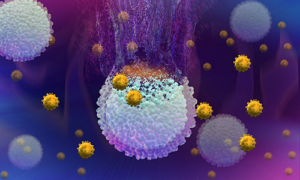 Immunotherapy is treatment that helps the immune system find and kill cancer cells. Immunotherapy works best for tumors that already have immune cells close by; these tumors are sometimes called “hot” or “inflamed” tumors. Immunotherapy does not work in many people with breast cancer, in part because these tumors have low numbers of immune cells and are considered “cold” or “not inflamed”. Researchers are looking for ways to make “cold” tumors “hot”, making them visible to the immune system and therefore more likely to respond to immunotherapy. Some of these strategies are being tested in clinical trials.
Immunotherapy is treatment that helps the immune system find and kill cancer cells. Immunotherapy works best for tumors that already have immune cells close by; these tumors are sometimes called “hot” or “inflamed” tumors. Immunotherapy does not work in many people with breast cancer, in part because these tumors have low numbers of immune cells and are considered “cold” or “not inflamed”. Researchers are looking for ways to make “cold” tumors “hot”, making them visible to the immune system and therefore more likely to respond to immunotherapy. Some of these strategies are being tested in clinical trials.
Read below to learn more about “hot” and “cold” tumors and strategies to convert “cold” breast cancer tumors to “hot” tumors that are being tested in clinical trials.
Introduction to “Hot” and “Cold” Tumors
- University of Chicago: A drug delivery system makes immunotherapy more effective in triple-negative breast cancer models
Ways to Turn “Cold” Breast Cancer Tumors Into “Hot” Tumors
- Moffitt Cancer Center: Researchers are activating the immune system with a vaccine and an immune-stimulating drug to treat HER2+ MBC
- Rush University Medical Center: Researchers are activating the immune system with the flu vaccine to treat triple-negative and HER2+ breast cancers
- University of Virginia: Researchers are activating the immune system with focused ultrasound to treat breast cancer
- Roswell Park Comprehensive Cancer Center: Activating the immune system with a combination of immune molecules converts “cold” triple-negative breast cancer tumors into “hot” tumors that respond to immunotherapy
MBC Clinical Trials
- Metastatic Trial Search: Trials for Vaccines and Immunotherapy
Last Modified on April 30, 2024
